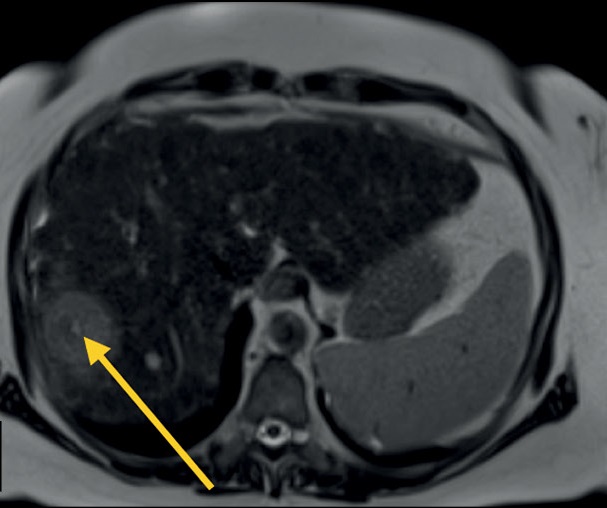Основные импульсные последовательности в диагностике абдоминальной патологии
- Авторы: Сыркашев Е.М.1,2, Кадырбердиева Ф.З.2, Абуладзе Л.Р.1, Семенов Д.С.1, Привалова Е.Г.1
-
Учреждения:
- Научно-практический клинический центр диагностики и телемедицинских технологий
- Национальный медицинский исследовательский центр акушерства, гинекологии и перинатологии имени академика В.И. Кулакова
- Выпуск: Том 4, № 1 (2023)
- Страницы: 39-50
- Раздел: Обзоры
- URL: https://journals.rcsi.science/DD/article/view/146874
- DOI: https://doi.org/10.17816/DD123543
- ID: 146874
Цитировать
Аннотация
Магнитно-резонансная томография является одним из основных методов диагностики заболеваний органов брюшной полости и забрюшинного пространства, который позволяет с высокой диагностической точностью и воспроизводимостью визуализировать очаговые или диффузные изменения паренхиматозных и полых органов. Магнитно-резонансная томография имеет определённые преимущества перед компьютерной томографией в чувствительности и специфичности определения патологических изменений паренхиматозных органов, желчевыводящих путей и протоков поджелудочной железы, брюшины и органов забрюшинного пространства.
Мультипараметрический протокол сканирования предоставляет информацию не только о взаимной топографии органов и их структуре, но и о функциональном состоянии тканей, что позволяет перейти от структурной к функциональной оценке изображений. В большинстве случаев стандартный протокол включает сканирование органов брюшной полости (Т1-/Т2- и диффузионно-взвешенные режимы) и желчевыводящих протоков (магнитно-резонансная холангиопанкреатография), при этом данный протокол может быть значительно сокращён или дополнен в зависимости от целей исследования и состояния пациента.
Существующие технические разработки и достижения позволяют упростить процесс сканирования и сократить время на получение изображений, повышая при этом воспроизводимость методик в разных учреждениях здравоохранения.
Полный текст
Открыть статью на сайте журналаОб авторах
Егор Михайлович Сыркашев
Научно-практический клинический центр диагностики и телемедицинских технологий; Национальный медицинский исследовательский центр акушерства, гинекологии и перинатологии имени академика В.И. Кулакова
Автор, ответственный за переписку.
Email: egorsrkshv@mail.ru
ORCID iD: 0000-0003-4043-907X
SPIN-код: 1901-5364
к.м.н.
Россия, Москва; МоскваФаина Залимхановна Кадырбердиева
Национальный медицинский исследовательский центр акушерства, гинекологии и перинатологии имени академика В.И. Кулакова
Email: k.faina1992@mail.ru
ORCID iD: 0009-0004-7787-3413
к.м.н.
Россия, МоскваЛия Руслановна Абуладзе
Научно-практический клинический центр диагностики и телемедицинских технологий
Email: AbuladzeLR@zdrav.mos.ru
ORCID iD: 0000-0001-6745-1672
SPIN-код: 8640-9989
MD
Россия, МоскваДмитрий Сергеевич Семенов
Научно-практический клинический центр диагностики и телемедицинских технологий
Email: semenovds4@zdrav.mos.ru
ORCID iD: 0000-0002-4293-2514
SPIN-код: 2278-7290
Россия, Москва
Екатерина Геннадьевна Привалова
Научно-практический клинический центр диагностики и телемедицинских технологий
Email: e-privalova@mail.ru
ORCID iD: 0000-0002-9851-9390
SPIN-код: 6546-5135
д.м.н.
Россия, МоскваСписок литературы
- Hussain S.M., Sorrell M.F. Liver MRI: Correlation with other imaging modalities and histopathology, second edition. Springer, 2015. doi: 10.1007/978-3-319-06004-0
- Runge V.M., Clanton J.A., Partain C.L., James A.E. Respiratory gating in magnetic resonance imaging at 0.5 Tesla // Radiology. 1984. Vol. 151, N 2. Р. 521–523. doi: 10.1148/radiology.151.2.6709928
- Bailes D.R., Gilderdale D.J., Bydder G.M., et al. Respiratory ordered phase encoding (ROPE): A method for reducing respiratory motion artefacts in MR imaging // J Comput Assist Tomogr. 1985. Vol. 9, N 4. Р. 835–838.
- American College of Radiology [интернет-ресурс]. ACR-SAR-SPR practice parameter for the performance of magnetic resonance (MR) Enterography. Режим доступа: https://www.acr.org/-/media/ACR/Files/Practice-Parameters/MR-Enterog.pdf. Дата обращения: 17.01.2023.
- Semelka R.C., Kelekis N.L., Thomasson D., et al. HASTE MR imaging: Description of technique and preliminary results in the abdomen // J Mag Reson Imaging. 1996. Vol. 6, N 4. Р. 698–699. doi: 10.1002/jmri.1880060420
- Rofsky N.M., Lee V.S., Laub G., et al. Abdominal MR imaging with a volumetric interpolated breath-hold examination // Radiology. 1999. Vol. 212, N 3. Р. 876–884. doi: 10.1148/radiology.212.3.r99se34876
- Syrkashev E.M., Solopova A.E., Kulabukhova E.A. Magnetic resonance imaging in the diagnosis of peritoneal carcinomatosis indisseminated ovarian cancer // Obstetrics Gynecology. 2020. N 9. Р. 38–47. doi: 10.18565/aig.2020.9.38-47
- Vanderveen K.A., Hussain H.K. Magnetic resonance imaging of cholangiocarcinoma // Cancer Imaging. 2004. Vol. 4, N 2. Р. 104–115. doi: 10.1102/1470-7330.2004.0018
- Kilcoyne A., Kaplan J.L., Gee M.S. Inflammatory bowel disease imaging: Current practice and future directions // World J Gastroenterol. 2016. Vol. 22, N 3. Р. 917–932. doi: 10.3748/wjg.v22.i3.917
- Koh D.M., Collins D.J. Diffusion-weighted MRI in the body: Applications and challenges in oncology // AJR Am J Roentgenol. 2007. Vol. 188, N 6. Р. 1622–1635. doi: 10.2214/AJR.06.1403
- Abuladze L.R., Semenov D.S., Panina O.Y., Vasilev Y.A. Optimized biparametric magnetic resonance imaging protocol for prostate cancer detection // Digit Diagnostics. 2022. Vol. 3, N 3. Р. 166–177. doi: 10.17816/dd108484
- Thoeny H.C., De Keyzer F. Extracranial applications of diffusion-weighted magnetic resonance imaging // Eur Radiol. 2007. Vol. 17, N 6. Р. 1385–1393. doi: 10.1007/s00330-006-0547-0
- Charles-Edwards E.M., De Souza N.M. Diffusion-weighted magnetic resonance imaging and its application to cancer // Cancer Imaging. 2006. Vol. 6, N 1. Р. 135–143. doi: 10.1102/1470-7330.2006.0021
- Kele P.G., van der Jagt E.J. Diffusion weighted imaging in the liver // World J Gastroenterol. 2010. Vol. 16, N 13. Р. 1567–1576. doi: 10.3748/wjg.v16.i13.1567
- Monticciolo L., Podberesky D.J., Pollack M.S., et al. ACR-SAR-SPR practice parameter for the performance of magnetic resonance imaging (MRI) of the abdomen (Excluding the Liver). Semantic Scholar; 2015. Режим доступа: https://www.semanticscholar.org/paper/ACR-%E2%80%93-SAR-%E2%80%93-SPR-PRACTICE-PARAMETER-FOR-THE-OF-(-MRI-Monticciolo-Podberesky/7dc9771a1b5aaec215c99fd74ab5e659738cf4fd. Дата обращения: 17.01.2023.
- Taron J., Martirosian P., Erb M., et al. Simultaneous multislice diffusion-weighted MRI of the liver: Analysis of different breathing schemes in comparison to standard sequences // J Magn Reson Imaging. 2016. Vol. 44, N 4. Р. 865–879. doi: 10.1002/jmri.25204
Дополнительные файлы


















